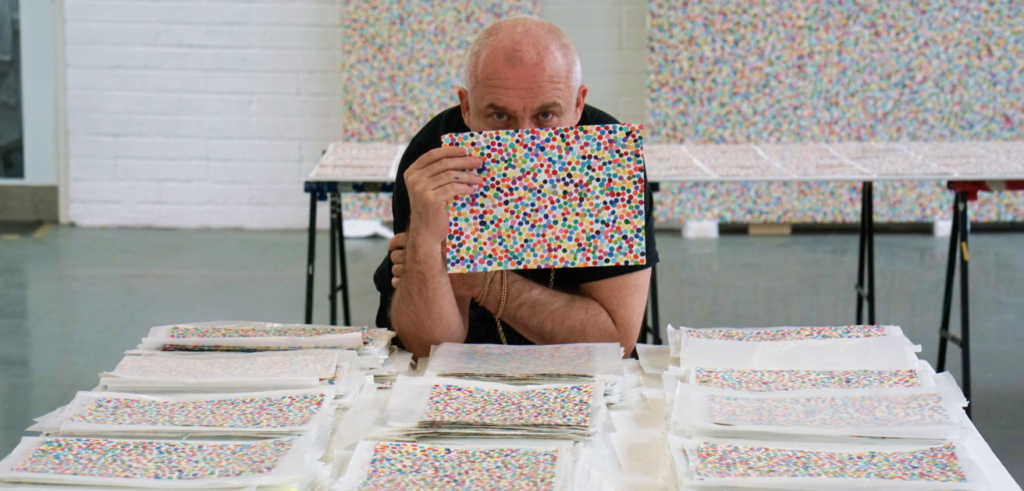Damien Hirst burns 1,000 works of art for an NFT project

“I decided I had to show my 100 percent support and trust in the NFT world (even if it means destroying the equivalent of 1,000 physical works of art).”

British art superstar Damien Hirst’s first NFT project The currency has just reached a critical deadline. Collectors have now officially considered whether to keep the physical paintings that came with their NFTs, or burn them to save the digital items.
The margin was narrow, but the paintings won. Exactly 5,149 collectors chose to keep their IRL artwork, and 4,851 chose the NFTs. Hirst himself had 1,000 works from the collection, and announced on Twitter that he would keep the NFTs to demonstrate his confidence in the project.
That means he chose to burn 1,000 of his own unique works of art.
The currencywhich was published last July, launching 10,000 of Hirst’s dot paintings stored in a secure UK vault on the eco-friendly Palm blockchain in partnership with online art firm HENI.
Hirst’s iconic dot series hit the art market in 1986, though the New York Times pointed out in January that his assistants have historically done the manual work of actually making them.
All 10,000 works with enamel paint on handmade paper date from 2016, when “Hirst dispensed with the rules for his Color Space paintings, allowing the work to become more organic,” says HENI. “The currency evolved from this exploration, with the spots appearing like particles or atoms.” Each is titled, stamped and signed, with a watermark, microdot and hologram by Hirst.
Titles are derived from machine learning applied to the artist’s favorite lyrics. Machine learning also identified key features such as dot density, paint texture and title length, and ranked each work in terms of respective rarity. Although no exact hue appears twice in the same painting, they worked out color rarity by mapping 10,000 RGB values and dividing them into seven groups.
You can search for different types of rarities in the collection’s online public gallery. Fun fact: only 1.22% of the works from the series have profanity in the title.
In keeping with the collector’s caveat, all discarded physical works will now be burned starting September 9 as part of a corresponding gallery show called The currency at the Newport Street Gallery in London. The rest will burn during the Frieze art fair in October.
As such, collectors who chose the physical paintings have also sacrificed their NFTs. Here, the term “burn” transcends the physical and digital. “Burning” cryptocurrencies and NFTs means sending them to a locked wallet that can only receive. People burn crypto for the same reason Hirst might burn his paintings or a fashion house might burn their merchandise.
Hirst first wanted to be a painter, but made a name and fortune as a sculptor and conceptual artist – best known for preserving sharks in formaldehyde, but also arranging calf heads, flies and insect zappers to comment on the paradoxically terrifying horrors of mortality. However, as the NYT wrote, Hirst has surrendered animals and made the market itself his medium.
NFTs proved to be a perfect fit for that practice, at their height. According to the NYT, The currency earned about $18 million from the first sale, and continuously collects 5% of all resales.
Between July 30 and August 31, 2021, the project’s first month live, it generated 2,036 sales totaling $47.9 million. “It acts all the time: It goes up and down, it has value one minute, and not the next,” Hirst told the NYT. “It’s like being in a cult and I’m the cult leader.”
Crypto winter appeared in May and they also suffered during the bear market. “Last month only 170 sales took place, raising $1.4 million,” Artnet wrote the day before the poll closed.
At this point, the project has generated $89 million. While the current average of $7,500 is a far cry from the project’s lifetime average of around $21,000, the physical works are already fetching $26,000 at the likes of Phillips London last January, Artnet added.
They later combed the project’s Discord and found that collectors felt that NFTs were “much faster and easier to sell”, while serving to sustain the project’s hype. Cons apparently included “nobody knows if nfts are a fad” and “nft and crypto market is hugely volatile.”
Other collectors said the physical prints “look even better in person” while providing “safe storage of wealth likely to increase in value.” On the other hand, physical artworks require insurance – but with the state of cryptocrime, perhaps NFTs should too – and of course withdrawal risk FOMO, should a crypto bull market reverse.
Until the fires start, Hirst apparently blurts out that his studio is trying to come to terms with the devastation that lies ahead. “Eeeek!” he ended the Twitter thread and announced collectors’ results. “I still don’t know what I’m doing.”
But Hirst’s creations have already met the same fate as burnt crypto, hidden indefinitely under lock and key. Mostly, Hirst cast an ancient skull in diamond-encrusted platinum and called it For God’s sakean earlier exploration of these 1:1 ideas of value.
He sold it for $100 million to a consortium of owners including himself and his gallery, White Cube. “It is now languishing in storage in Hatton Garden, London’s jewelry district,” Hirst said in the NYT post. At least with The currencyHirst’s burnt paintings can feel free – even if his Twitter fans feel the paintings are better in their hands.
Tags: art Cryptocurrency Damien Hirst Entertainment NFTs
























